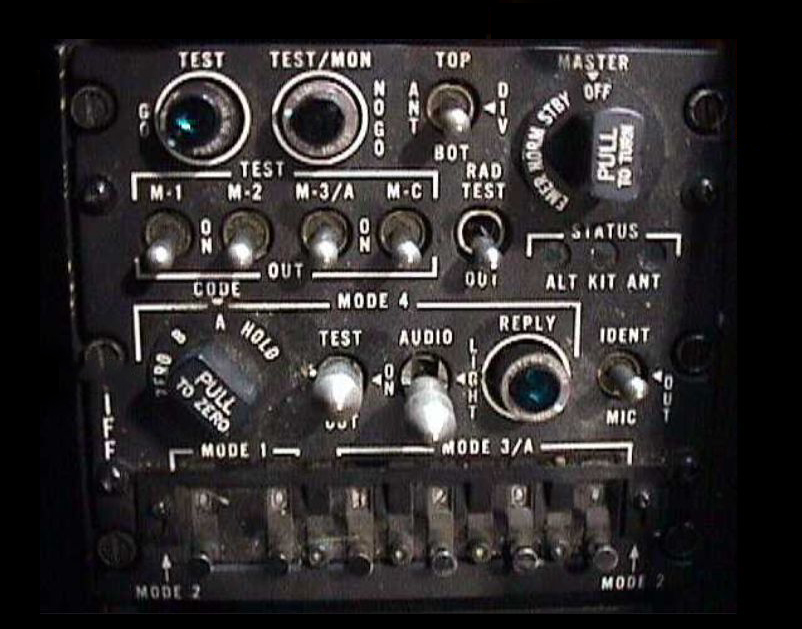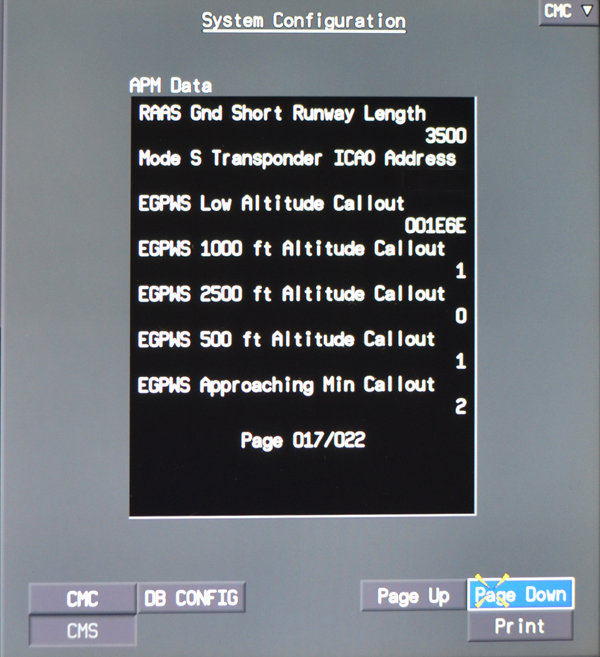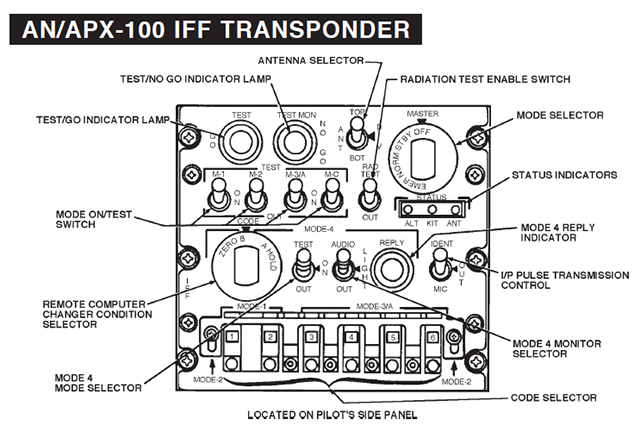Most of this stuff is common knowledge, perhaps we miss a few things here and there. When exactly do you squawk 2000? What does that former Air Force guy mean when he says IFF? What is a secondary target? More recently: where do you find your Mode S squawk?
— James Albright
1
History
IFF
Identification, friend or foe — A device that emits a signal positively identifying it as a friendly.
Source: DoD Dictionary of Military and Associated Terms, pg. 123
You will often hear "IFF" from ex-military types when what they mean to say is "transponder." While the IFF found in many military aircraft are much more than just transponders, for our purposes the terms can be considered synonymous.
ATC: Primary versus Secondary Radar
PRIMARY RADAR TARGET− An analog or digital target, exclusive of a secondary radar target, presented on a radar display.
Source: Air Traffic Organization Policy Order JO 7110.65U, pg. PCG P-4
SECONDARY RADAR TARGET− A target derived from a transponder return presented on a radar display.
Source: Air Traffic Organization Policy Order JO 7110.65U, pg. PCG S-2
The primary target is the "blip" on the controllers radar screen that is nothing more than the aircraft's radar return, while the secondary target is the signal and information beamed from the aircraft's transponder to the radar.
2
Modes
Mode 1 (Military)
This was a two digit code we could set depending on mission.
Mode 2 (Military)
I've heard this code told the good guys what your mission is and was set for each aircraft, though aircraft I've flown allowed us to change this in flight.
Mode 3 (Military) / Mode A (Civilian)
This is the 4-digit code we set in the cockpit as assigned by ATC or what we are doing at the time, often called "Mode 3/A" and usually combined with Mode C to provide altitude information.
Mode 3 (Military) / Mode C (Civilian)
Provides the aircraft's pressure altitude, sometimes called "Mode 3C."
Mode 4 (Military)
Provides a 3-pulse reply to crypto coded challenge.
Mode 5 (Military)
Provides a cryptographically secured version of Mode S and ADS-B GPS position.
Mode S (Military and Civilian)
Provides multiple information formats to a selective interrogation. Each aircraft is assigned a fixed 24-bit address.
Example. The G450 Aircraft Operating Manual mentions the Mode S code in §2B-21-00, page 33, saying it can be found on the MCDU DLK (AOC) STATUS page 3, but that does not appear to be true. I have found the code on the CMS, page 17. (I erased our code from the photo.)
The code is simply a hexadecimal conversion from your registration.
You can check this at: http://www.avionictools.com/.
Mode 1 (Military)
This was a two digit code we could set depending on mission.
Mode 2 (Military)
I've heard this code told the good guys what your mission is and was set for each aircraft, though aircraft I've flown allowed us to change this in flight.
Mode 3 (Military) / Mode A (Civilian)
This is the 4-digit code we set in the cockpit as assigned by ATC or what we are doing at the time, often called "Mode 3/A" and usually combined with Mode C to provide altitude information.
Mode 3 (Military) / Mode C (Civilian)
Provides the aircraft's pressure altitude, sometimes called "Mode 3C."
Mode 4 (Military)
Provides a 3-pulse reply to crypto coded challenge.
Mode 5 (Military)
Provides a cryptographically secured version of Mode S and ADS-B GPS position.
Mode S (Military and Civilian)
Provides multiple information formats to a selective interrogation. Each aircraft is assigned a fixed 24-bit address.
Example. The G450 Aircraft Operating Manual mentions the Mode S code in §2B-21-00, page 33, saying it can be found on the MCDU DLK (AOC) STATUS page 3, but that does not appear to be true. I have found the code on the CMS, page 17. (I erased our code from the photo.)
The code is simply a hexadecimal conversion from your registration.
You can check this at: http://www.avionictools.com/.
3
Codes
1200 — VFR
Transponder Operation Under Visual Flight Rules (VFR): Unless otherwise instructed by an ATC facility, adjust transponder to reply on Mode 3/A Code 1200 regardless of altitude.
Source: Aeronautical Information Manual, ¶4-1-17.g.
There may be other examples, but for at least in the U.S., squawk 1200 when VFR.
2000 — Oceanic
[] Except in case of emergency, communication failure or unlawful interference (see 1.4, 1.5 and 1.6), the pilot shall:
a) operate the transponder and select Mode A codes as directed by the ATC unit with which contact is being made; or
b) operate the transponder on Mode A codes as prescribed on the basis of regional air navigation agreements; or
c) in the absence of any ATC directions or regional air navigation agreements, operate the transponder on Mode A Code 2000.
Source: ICAO Doc 8168, Vol III, §III-3-1-1, ¶1.1.2
Africa-Indian Ocean Regional Supplementary Procedures. Unless otherwise directed by air traffic control, the last assigned SSR (Mode A) code shall be retained. If no SSR code has been assigned, Mode A code 2000 shall be selected and retained.
Source: ICAO Doc 7030, §AFI, ¶5.1.1.2.
All aircraft operating as IFR flights in the NAT Region shall be equipped with a pressure altitude reporting SSR transponder. Radar control services are provided in particular portions of the NAT Region (e.g. the southern and eastern portions of Reykjavik OCA). Here, transponder codes issued by the controlling authority must be retained until advised. Otherwise, unless directed by ATC, pilots flying in the NAT FIRs will operate transponders continuously in Mode A/C Code 2000, except that the last assigned code will be retained for a period of 30 min after entry into NAT airspace or after leaving a radar service area. Pilots should recognise that it is important to change from the last assigned domestic code to the Mode A/C Code 2000 since the original domestic code may not be recognised by the subsequent Domestic Radar Service on exit from the oceanic airspace. (One exception to this requirement should be noted. Because of the limited time spent in the NAT HLA when flying on Route Tango 9, the change from the last assigned domestic code to Code 2000 should be made Northbound 10 minutes after passing BEGAS and Southbound 10 minutes after passing LASNO.)
Source: NAT Doc 007, ¶10.2.1
Change your transponder code to 2000 in accordance with regional requirements. This requirement varies with the oceanic airspace. You should confirm these procedures, through applicable AIP or other regional documents during flight planning. In the North Atlantic, for example, the transponder code should be changed 30 minutes after entering oceanic airspace.
Source: AC 91-70B ¶6.4.3.1
You must ensure that you comply with transponder procedures as contained in ICAO Procedures for Air Navigation Services—Aircraft Operations (PANS-OPS) Document 8168 and, in the absence of other directions from air traffic control (ATC), operate your transponder on Mode A and C code 2000.
Source: AC 91-70B ¶E.5.4
In general you are going to squawk 2000 when oceanic, waiting 30 minutes after the entry waypoint is required over the North Atlantic and doesn't hurt elsewhere. There are exceptions so make sure you view the regional pages before entry.
7500 — Hijacking
An aircraft equipped with an SSR transponder is expected to operate the transponder on Mode A Code 7500 to indicate specifically that it is the subject of unlawful interference.
Source: ICAO Doc 4444, ¶15.1.3.2
- If there is unlawful interference with an aircraft in flight, the pilot-in-command shall attempt to set the transponder to Mode A Code 7500 in order to indicate the situation. If circumstances so warrant, Code 7700 should be used instead.
- If a pilot has selected Mode A Code 7500 and has been requested to confirm this code by ATC (in accordance with 1.1.5), the pilot shall, according to circumstances, either confirm this or not reply at all.
- Note.— If the pilot does not reply, ATC will take this as confirmation that the use of Code 7500 is not an inadvertent false code selection.
Source: ICAO Doc 8168, Vol III, §4-1-2, ¶1.6
When requested by ATC to CONFIRM SQUAWK (code), the pilot shall:
a) verify the Mode A code setting on the transponder;
b) reselect the assigned code if necessary; and
c) confirm to ATC the setting displayed on the controls of the transponder.
Source: ICAO Doc 8168, Vol III, §4-1-1, ¶1.1.5
7600 — Lost Comm
An aircraft equipped with an SSR transponder is expected to operate the transponder on Mode A Code 7600 to indicate that it has experienced air-ground communication failure.
Source: ICAO Doc 4444, ¶8.5.2.1
The pilot of an aircraft losing two-way communications shall set the transponder to Mode A Code 7600. Note.— A controller who observes an SSR response indicating selection of the communications failure code will determine the extent of the failure by instructing the pilot to SQUAWK IDENT or to change code. If it is determined that the aircraft receiver is functioning, further control of the aircraft will be continued using code changes or IDENT transmission to acknowledge receipt of clearances. Different procedures may be applied to Mode S equipped aircraft in areas of Mode S coverage.
Source: ICAO Doc 8168, Vol III, §4-1-2, ¶1.5
7700 — Emergency
The pilot of an aircraft in a state of emergency shall set the transponder to Mode A Code 7700 unless ATC has previously directed the pilot to operate the transponder on a specified code. In the latter case, the pilot shall continue to use the specified code unless otherwise advised by ATC. However, a pilot may select Mode A Code 7700 whenever there is a specific reason to believe that this would be the best course of action.
Source: ICAO Doc 8168, Vol III, §4-1-2, ¶1.4
References
(Source material)
Advisory Circular 91-70B, Oceanic and International Operations, 10/4/16, U.S. Department of Transportation
Aeronautical Information Manual
Air Traffic Organization Policy Order JO 7110.65U, February 9, 2012, U.S. Department of Transportation
Department of Defense Dictionary of Military and Associated Terms, Joint Publication 1-02, 15 November 2013
ICAO Doc 4444 - Air Traffic Management, 16th Edition, Procedures for Air Navigation Services, International Civil Aviation Organization, October 2016
ICAO Doc 4444, Amendment 9 to the PANS-ATM, 15 June 2020
ICAO Doc 7030 - Regional Supplementary Procedures, International Civil Aviation Organization, Fifth Edition, 2008
ICAO Doc 7030, Amendment 1, International Civil Aviation Organization, 8 January 2009
ICAO Doc 8168 - Aircraft Operations - Vol III - Flight Procedures, Procedures for Air Navigation Services, International Civil Aviation Organization, First Edition, 2018
ICAO Nat Doc 007, North Atlantic Operations and Airspace Manual, v. 2021-1, applicable from February 2021




